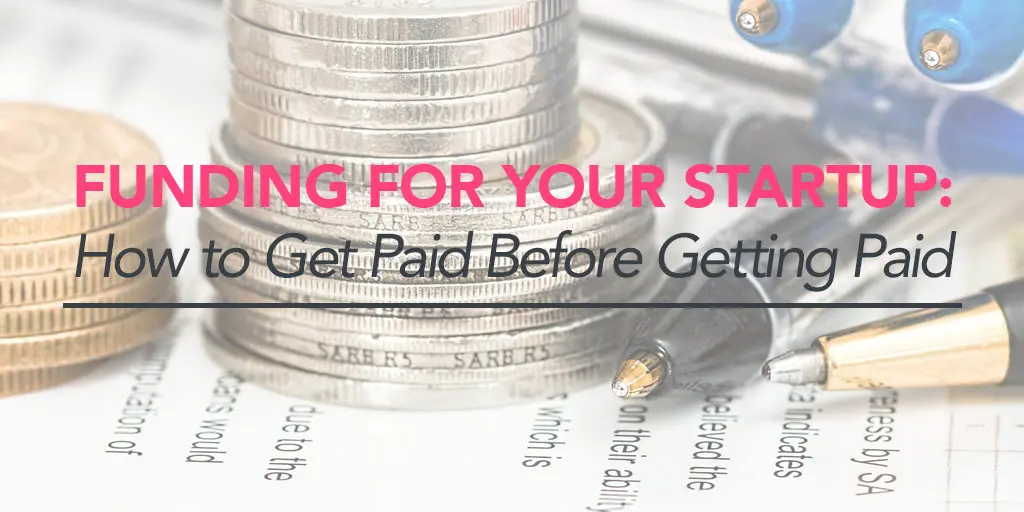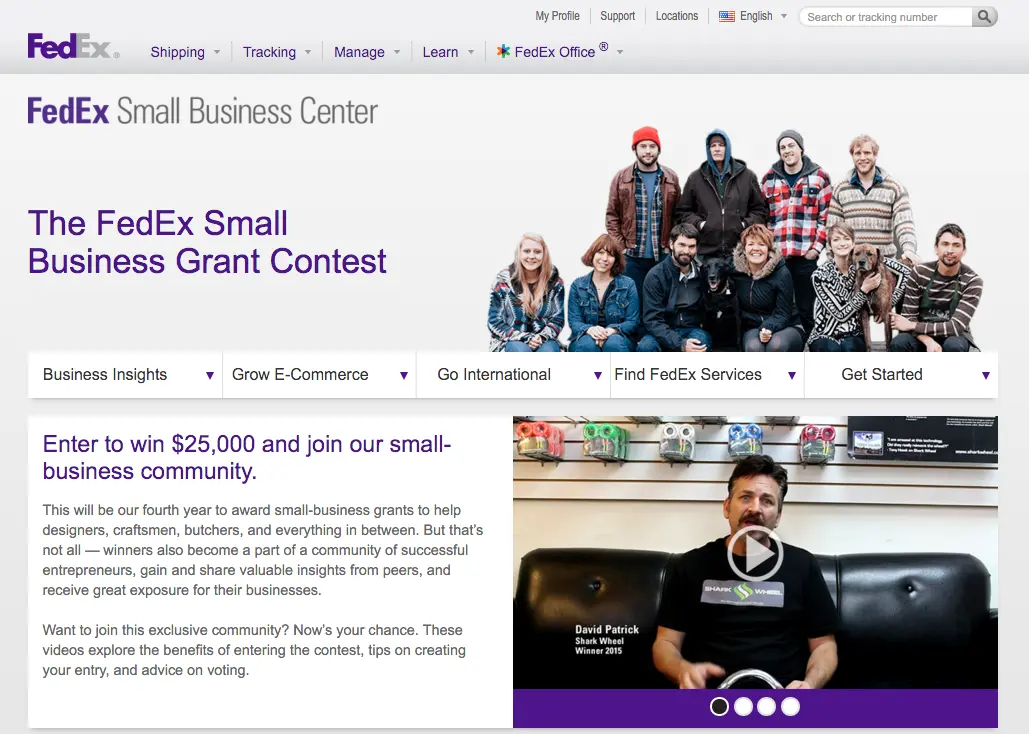
Do you need money, like yesterday?
Pull up a chair. Let’s discuss. There are two ways to a payday.
One way requires you to wait politely in line for a future, after I’ve hustled hard enough, held my head just right, and paid my dues payday.
And then there’s another way that allows you to skip ahead to the front of the line where you can dive directly into cash.

I know which one I’d choose. So, instead of watching that gif on repeat with longing, let’s create an action plan to make it happen.
There are 3 main ways to fund your startup: bootstrap, investors, or get your customers to pay. Click To Tweet
There are three main avenues to fund your startup: bootstrapping it, asking others to invest, or getting your customers to pay for it. Each one of these are doable but not without their own set of difficulties.
Here’s how we’ll break it down. Below, we’ll discuss the different types of funding available for startup businesses along with the pros and cons of each. By the end of this post, you should have a better understanding of which type of funding would work best for your business right now. And remember, you can also switch funding methods. You’re not tied to one type of funding. Let’s get started.
Bootstrap It
Bootstrapping your startup is, in many ways, the easiest method. Depending on the method you use, you will not owe anyone anything. You’ll reap all of the rewards, or 100% of the pie.
First, a word of caution:
Bootstrapping is not without risks. You can end up losing a huge chunk of your savings, or worse. You could end up deep in debt also, affecting your ability to qualify for future purchases and services.
On one hand, you should be very caution when putting your money and good name on the line for your fledgling startup.
On the other hand, if you don’t believe in yourself, no one else will. Show yourself and others that you have skin in the game by investing in yourself first.
Your Bank Account
Work on your dream while you keep your day job. Invest a portion of your paycheck into your business. Or, you can tap into your savings to power your business. Because new businesses are always risky investments, I wouldn’t suggest wiping out your entire savings, though. Leave room to recover, if necessary.
Your Credit Cards
Credit cards are a risky move, but, it’s just so darn convenient to charge it, am I right?

When using credit cards to fund your business, be prudent. It’s easy to get in over your head, especially if you’re paying a higher interest rate. You may even find yourself transferring balances from one card to the next in order to avoid hefty interest payments.
The benefits of using credit cards to fund your business are:
+You may enjoy a lower interest rate than other types of funding.
+You can build credit for your business if you set up a business account.
The downside of using credit cards to fund your business are:
-You have a lower credit limit than other options.
-You may be held personally liable if you miss payments. This can affect your personal credit score.
A Traditional Lender
A bank is a traditional lender that many startup businesses consider first when looking for outside funding sources. Because banks generally lend a higher amount than you’d have access to with a credit card, you’ll need to meet certain requirements.
Banks are very interested in your credit score. You need at least a credit score of 650 (preferably above) to get taken seriously by a bank. You’ll also need a solid business plan.
Keep in mind that your bank is not an investor. They are not interested in taking on risk. Instead, your bank expects a concrete plan for when and how their loan to you will be repaid. For this reason, many banks prefer to lend after you’ve proven your business with a profit.
Grants

What’s better than free money with no strings attached? Uh, nothing.
That’s exactly what a grant is. It’s an endowment gifted to you just for meeting certain requirements. While a grant may be free, you do need to read and follow the instructions carefully. You’ll also need to prepare a grant proposal that highlights your business as a worthy recipient.
Keep in mind that after your grant is gifted, you’ll still need to provide updates about how you’ve used the grant money.
Places to look for grants:
Rollover for Business Startup (ROBS)
Another way to fund your startup yourself is through an arrangement known as Rollover for Business Startups, or ROBS for short. With a ROBS, you can borrow up to 100% of your 401(k), traditional IRA, or other type of eligible retirement account as long as it’s worth at least $50,000.
The benefit of ROBS is that you won’t pay penalties or taxes when using money from an eligible retirement account to fund your startup.
The drawback of ROBS is that, if your business goes under, you will have wiped out or put a significant dent in your retirement fund.
ROBS is a pretty complicated subject. If you’d like to learn more about it, check out this guide: Rollover For Business Startups (ROBS) – The Ultimate Guide.
Ask Your Friends and Family
Because that’s what friends are for… right? Sure, no one wants to feel like an ATM, but if you’re not the type to constantly ask for money (you know who you are), and if you’re truly passionate about your startup, you may be able to convince friends and family to invest in you.
But keep in mind that money and family don’t often mix. Be clear with them from the get-go that there are risks involved, and your loved one may not ever see a return on their investment.
In fact, get it in writing.
When you’re dealing with loved ones, you have to be super duper clear on the details of the investment. And you should probably explain that investing in your business doesn’t automatically turn them into equal partners (unless that’s what you want).
If you’re offering equity in your startup, explain how much of the pie you’ll give in exchange for their investment (3%, 5%, 7%, and so on).
Once again, get it in writing.

Angel Investors
When it’s time to get more money for your startup, you may consider looking for an angel investor. Angel investors are wealthy accredited investors who, on average, invest $1.6 million over a period of five years.
Angel investors will usually only invest in a specific industry. Some angel investors only invest in tech startups, others healthcare, and so on. This is because angel investors are often concerned with mentorship. They invest their own money, but they also invest guidance to help you develop your idea.
For this reason, you can seek an angel investor while you’re still in the early stages of product development.
You will need to determine how much equity in your business you’ll offer in exchange for their investment. Don’t be afraid to negotiate until you come up with a deal that you can feel good about.
You’ll also need to determine what level of control and involvement you’re okay with upfront. Many angels prefer to be hands-on, and if you’re not okay with that, you may need to step away from their offer.
To find the right angel investors for your startup, check out AngelList.
Venture Capitalists
Approaching a venture capitalist (VC) is often the next stage of funding. This stage usually occurs years down the road, after you’ve developed your idea with an angel investor.
VCs are willing to invest more money, but they also expect a higher return on their investment.
Let’s say you receive a $5 million dollar investment. Your VC will expect a $50 million dollar return. If you have a company who wants to buy your startup for $30 million, your venture capitalist investors can and often will block the sale. You need to understand this is a likely possibility before agreeing to their investment.
To find the right VC for you, check out this list of The Top 100 Venture Capitalist Investors in Early-Stage Startups.
Get Your Customers Involved
Last, but certainly not least, consider getting your customers involved in the funding process. After all, these are the people who will make or break your business, so why not make them a part of the conversation early on?

Here are a few ways to do just that:
Ask for Upfront Payment
Do you offer only special made-to-order products? Get the money upfront which will allow you to purchase necessary supplies without needing to dig into your pocket.
Go with Crowdfunding
Let’s discuss crowdfunding. Crowdfunding is asking a group of people (a crowd) to contribute money in exchange for a product, a stake in your company, or another reward.
There are three types of crowdfunding: donation, equity, and rewards. Here’s how they break down:
Equity – The crowd donates funds in exchange for equity, or a share, in your company. The crowd becomes part-owners because they are actually purchasing shares in your company. Equity crowdfunding is only available to accredited investors.
What makes an accredited investor?
An accredited investor is someone who has a networth of at least $1 million dollars, or has received an income of more than $200,000 for the previous two years.
The government limits the type of investors who can own equity in your private startup. In other words, you can’t offer equity in your private business to strangers, unless they are accredited investors. Otherwise, your early investors must be friends and family. The government places these restrictions on private businesses to protect the public from getting scammed. How thoughtful.
Donation – This type of donation is fundraising, pure and simple. A donation is any type of crowdfunding that doesn’t result in a financial return to the crowd of investors. It’s usually reserved for personal events, such as taking up money for an unexpected medical bill. However, you may be able to persuade a crowd to invest in your startup this way, too.
Rewards – This type of donation asks a crowd to send funds in exchange for a product, service or other tangible reward. Rewards can be in the form of a t-shirt, hat, or plaque, for starters. In this type of crowdfunding, you don’t promise an individual equity in your business, which opens up funding to anyone willing, not just accredited investors.
Only about 2% of businesses use crowdfunding, but that doesn’t mean the marketplace isn’t saturated. A cursory glance at popular crowdfunding site Kickstarter shows that there are a lot of businesses looking for funding. That’s the downside.
On the bright side, crowdfunding opens you up to a larger pool of investors without having to send precious time and other resources finding, meeting with, and wooing them. You can do it all on one platform.
To stand out from the crowd, you’ll need to do something that separates you from the rest. You’ll do that with a compelling backstory and a killer video. Videos that share your story really seal the deal when it comes to crowdfunding.
Another benefit of crowdfunding is that you can use it to do market research. You’ll learn whether there’s an interest for your product.
On the other hand, your business idea will be visible to any and all, which increases the possibility that others may steal your ideas and use it as their own.
If you’re interested in crowdfunding, check out Indiegogo, GoFundMe, Kickstarter, or Fundable.
Would you like more posts like this in the future?
Send us a tweet @KickoffLabs to let us know how you enjoyed this post and if you’d like to read more posts about startup funding.